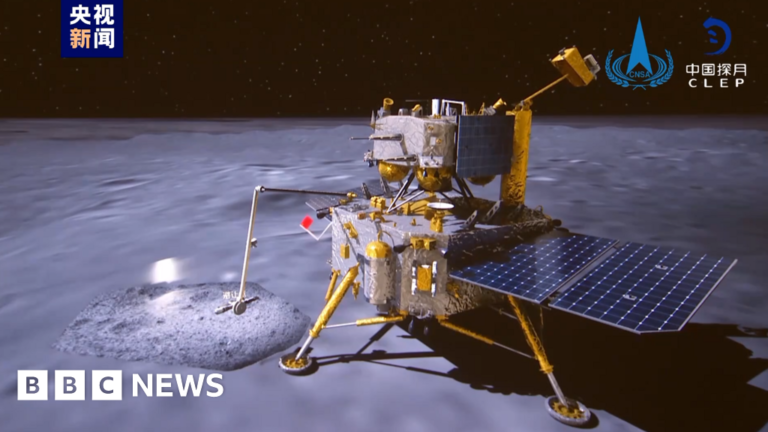- author, Francis Mao
- role, BBC News
China has announced that a lunar probe has been successfully launched from the far side of the moon and has begun its return journey to Earth carrying samples collected from that area for the first time.
The Chang’e-6 module, named after the moon goddess in Chinese mythology, successfully launched at about 7:38 a.m. on Tuesday (11:38 p.m. GMT on Monday) and began its return journey, state media said.
The probe landed near the moon’s south pole on Sunday, a world-first achievement hailed by the international scientific community.
China is the only country to have landed on the far side of the moon, having done so in 2019.
The China National Space Administration called the mission “an unprecedented feat of human lunar exploration.”
That side of the Moon, which always faces away from Earth, is technically difficult to reach due to its rugged terrain and deep craters.
The Chinese mission aims to be the first to bring back rock and soil samples from the region, which scientists say could be significantly different from rock layers on the moon’s near side.
State media showed a video released by China’s space agency showing the unmanned robotic craft sticking out its tiny arm and waving the Chinese flag after collecting the precious samples.
Chinese state media announced the successful launch of the module on Tuesday, citing the CNSA as saying the probe’s ascent module “has lifted off from the lunar surface.”
“The mission withstood high temperature testing on the far side of the moon,” the space agency said.
After liftoff, the module entered a “pre-determined orbit around the Moon.”
The entire probe is expected to return to its landing site in Inner Mongolia within about three weeks.
Chinese scientists will be given the first opportunity to analyze the rocks, after which researchers from around the world will be able to apply for the opportunity.
The probe landed on Sunday in a huge crater known as the South Pole-Aitken Basin, one of the largest known craters in the solar system.
The landing was fraught with risk, as reaching the far side of the moon would make communication with the spacecraft extremely difficult.
China’s space agency said the operation involved “a lot of technological innovation, high risks and great difficulties.”
The mission was intended to use a drill and mechanical arm to extract about 2 kilograms (4.4 pounds) of material, according to the CNSA.
Experts previously told the BBC that new rocks may be present.
“Everyone is very excited about the possibility of seeing rocks that no one has seen before,” said John Parnett Fisher, professor of lunar geology at the University of Manchester.
He has previously analysed moon rocks returned by the US Apollo missions and by an earlier Chinese mission.
But the opportunity to analyze rocks from completely different regions of the moon could help answer fundamental questions about how planets form, he says.
The lunar south pole is the next frontier for lunar exploration missions, and countries are eager to understand the region because of the high probability of ice present there.
Access to water would greatly increase the chances of successfully establishing a human lunar base for scientific research.
This is the second time China has launched a lunar sample collection mission.
In 2020, Chang’e 5 brought back 1.7 kg of material from a region on the near side of the moon called the Ocean of Storms.
In 2019, China became the first country to reach the other side of the Earth with the landing of Chang’e-4.
China is looking to search for water on the moon and establish a permanent base there, and plans three more unmanned missions this decade.
Beijing’s broader strategy aims for Chinese astronauts to walk on the moon by around 2030.
The United States also aims to send astronauts to the Moon again, with NASA aiming to launch the Artemis 3 mission in 2026.

